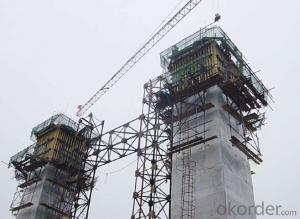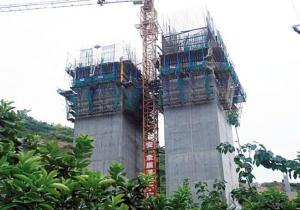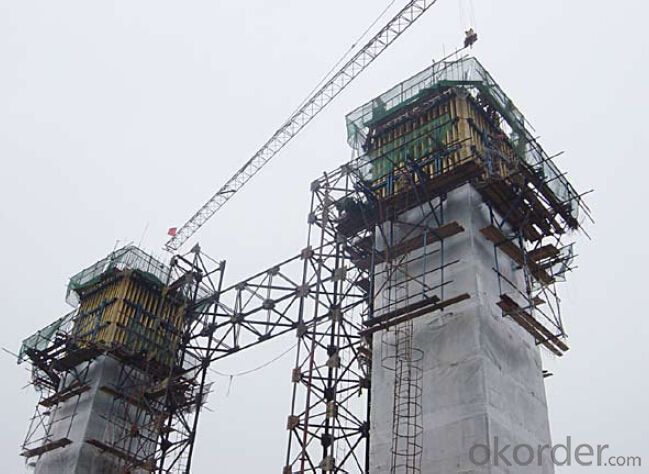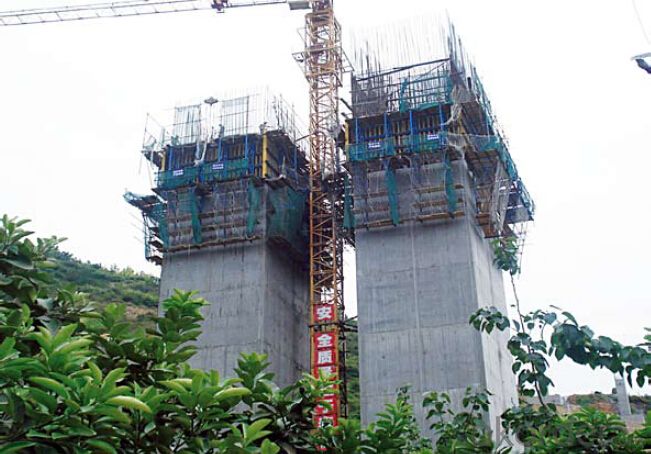Climbing Bracket for Formwork and Scaffolding System
- Loading Port:
- Tianjin
- Payment Terms:
- TT OR LC
- Min Order Qty:
- 50 m²
- Supply Capability:
- 1000 m²/month
OKorder Service Pledge
OKorder Financial Service
You Might Also Like
Climbing Bracket CB240 & CB210
They are framework brackets for supporting large-area wall formwork.
Typical applications for the CB240&CB210 are pier and column/shear wall/core walll/ in the
building.
CB210 has smaller size than CB240, it will be cost effective in some condition.
Characteristics:
◆ High bearing capacity
The high loading capacity of the brackets allow very large scaffold units. This saves the number
anchor points required as well as reducing climbing times.
◆ Simple moving procedure by crane
Through the strong connection of formwork together with the climbing scaffold, both can be moved
as a single climbing unit by crane. Thus valuable time-savings can be achieved.
◆ Fast striking process without a crane
With the retrusive set, large formwork elements can also be retracted quickly and a minimum of
effort.
◆ Safe with work platform
The platforms have assembled firmly with bracket and will be climbing together, without scaffolding
but can work safely in spite of your high location.
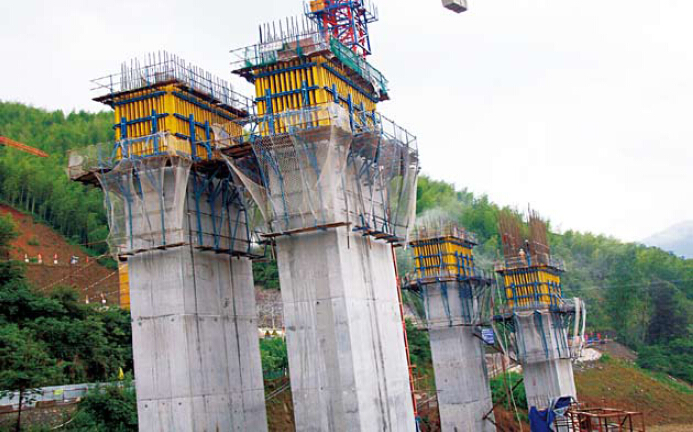
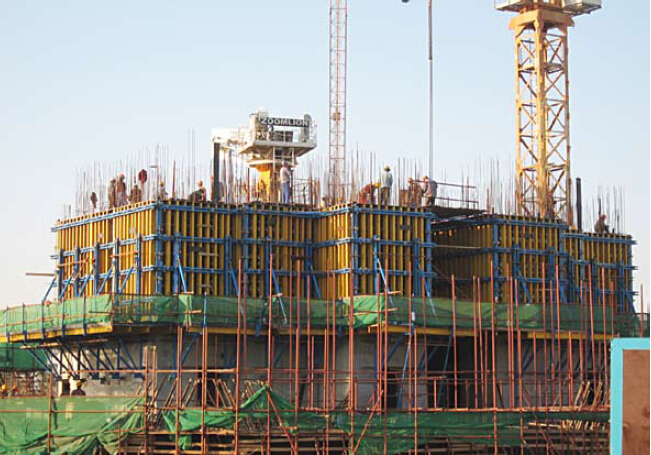
- Q: What are the different safety training requirements for steel formwork installation?
- The different safety training requirements for steel formwork installation typically include proper use and handling of equipment, knowledge of safety protocols and procedures, understanding of personal protective equipment (PPE), awareness of potential hazards and how to mitigate them, and training on emergency response and evacuation procedures. Additionally, workers may need to undergo specific training related to fall protection, scaffolding, and other specialized tasks involved in steel formwork installation.
- Q: How do steel formwork systems differ from one another?
- Steel formwork systems can differ from one another in several ways. Firstly, they can vary in terms of their design and construction. Some steel formwork systems are modular, meaning they consist of pre-assembled panels that can be easily connected and adjusted to form different shapes and sizes. Others may be custom-made for specific projects, offering more flexibility in terms of formwork design. Secondly, steel formwork systems can differ in terms of their strength and durability. Some systems are designed to withstand heavy loads and extreme conditions, making them suitable for large-scale construction projects. Others may be lighter and more portable, making them ideal for smaller projects or areas with limited access. Another factor that distinguishes steel formwork systems is their ease of use. Some systems are designed to be user-friendly, with features such as built-in handles, adjustable brackets, and easy-to-use locking mechanisms. These systems allow for quick and efficient installation and dismantling, saving time and effort on the construction site. Additionally, steel formwork systems can differ in terms of their finishing options. Some systems offer smooth and precise finishes, ideal for projects that require a high-quality surface. Others may have textured or patterned finishes, providing a decorative element to the concrete structure. Lastly, steel formwork systems can differ in terms of their cost and availability. Some systems may be more affordable and readily available, making them a popular choice for smaller projects or budget-conscious contractors. Other systems may be more expensive or require longer lead times for fabrication, but offer advanced features or customization options. Overall, the differences between steel formwork systems lie in their design, strength, ease of use, finishing options, and cost. Contractors and construction professionals should carefully evaluate these factors to select the most suitable steel formwork system for their specific project requirements.
- Q: How does steel formwork compare to other formwork materials in terms of durability?
- Steel formwork is highly regarded for its exceptional durability when compared to other formwork materials. Steel is known for its strength and resilience, making it a reliable choice for construction projects that require long-lasting formwork. Unlike materials like wood or plastic, steel formwork is resistant to warping, cracking, and rotting, ensuring its longevity and effectiveness over time. Additionally, steel formwork is highly resistant to the elements, including harsh weather conditions and exposure to chemicals. It can withstand heavy loads and pressures, making it suitable for projects that involve high-rise buildings, bridges, or other structures that require robust support during the construction process. Furthermore, steel formwork offers the advantage of being reusable. After a concrete pour, steel formwork can be easily dismantled, cleaned, and reassembled for future use. This reusability factor not only reduces construction waste but also proves to be cost-effective in the long run. However, it is important to note that steel formwork requires regular maintenance to prevent corrosion. Proper cleaning, rust removal, and application of protective coatings are necessary to ensure the formwork's durability and extend its lifespan. In summary, steel formwork outperforms other formwork materials in terms of durability due to its strength, resistance to various elements, and reusability. While it requires maintenance to prevent corrosion, steel formwork remains a preferred choice for construction projects that demand long-lasting and reliable formwork solutions.
- Q: How does steel formwork affect the overall sustainability of a construction project?
- The overall sustainability of a construction project can be significantly influenced by the use of steel formwork. Firstly, the durability and reusability of steel formwork greatly reduces the need for constant replacement, resulting in minimal waste generation and a reduced environmental footprint. This not only benefits the project's environmental impact but also aids in cost reduction. Additionally, the use of steel formwork ensures a high level of accuracy and precision, leading to efficient and streamlined construction processes. This in turn reduces material wastage and energy consumption, contributing to the sustainable use of resources. Moreover, the utilization of steel formwork enables faster construction cycles, resulting in decreased overall energy consumption and greenhouse gas emissions. Furthermore, steel formwork offers versatility in design, allowing for the creation of complex and innovative architectural structures. This versatility enhances the aesthetic appeal of a building, promoting its long-term use and decreasing the likelihood of demolitions due to outdated designs. By extending the lifespan of a structure, steel formwork contributes to the sustainability of the project by reducing the need for additional construction and material usage. In addition, steel formwork plays a crucial role in ensuring the overall structural integrity and safety of a building. Its strength and rigidity provide stability during both construction and throughout the lifespan of the structure. This reduces the risk of structural failures and the need for repairs or reconstruction, consequently minimizing waste generation and resource depletion. To summarize, the use of steel formwork has various positive impacts on the overall sustainability of a construction project. Its durability, reusability, precision, efficiency, versatility, and structural integrity contribute to the reduction of waste generation, energy consumption, and greenhouse gas emissions. By promoting the sustainable use of resources and contributing to the long-term viability of buildings, steel formwork plays a crucial role in sustainable construction practices.
- Q: Is steel formwork suitable for all types of construction projects?
- No, steel formwork may not be suitable for all types of construction projects. It is commonly used in large-scale projects that require repetitive use of formwork, such as high-rise buildings or bridges. However, for smaller or more intricate projects, other types of formwork materials like wood or plastic may be more appropriate. The choice of formwork depends on factors such as project size, complexity, budget, and specific requirements.
- Q: What are the different types of edge protection used with steel formwork?
- To ensure safety and prevent accidents on construction sites, various types of edge protection are utilized with steel formwork. Here are some commonly used options: 1. Edge protection barriers: These sturdy barriers, typically constructed from materials like steel or aluminum, are installed along the formwork's edges. Their purpose is to physically obstruct workers from unintentionally falling off. These barriers are adjustable, making them easy to install and remove as needed. 2. Toe boards: Usually made of wood or steel, toe boards are positioned along the lower edge of the formwork. Their role is to act as a barrier, preventing tools, equipment, or debris from falling off. Additionally, they serve as a visual reminder for workers to exercise caution near the edge. 3. Handrails: Attached to vertical posts, handrails are horizontal bars placed along the formwork's edges. They offer workers a secure grip, aiding in balance and stability, especially when working at elevated heights. Safety regulations often mandate the installation of handrails in specific situations. 4. Safety nets: These nets are positioned beneath the formwork to catch any falling objects or debris. Typically crafted from robust mesh material, safety nets are designed to absorb the impact of such items. They prove especially beneficial during activities where there is a risk of objects falling off, such as concrete pouring or formwork removal. 5. Harnesses and lifelines: In high-risk scenarios, workers may be required to wear harnesses and employ lifelines to safeguard against falls. These systems consist of a harness worn by the worker, which is connected to a securely anchored lifeline. Harnesses and lifelines provide an additional layer of protection when edge protection alone may not suffice. It is important to consider project-specific requirements, local regulations, and the level of risk involved when selecting edge protection measures. Construction companies must thoroughly assess site conditions and implement appropriate measures to ensure worker safety.
- Q: Who used plastic building template? How is the effect? What are the advantages and disadvantages?
- Plastic building template is an energy-saving and environment-friendly products, after the wooden template, composite steel formwork, bamboo plywood, all steel template and a new type of product. Can completely replace the steel formwork, formwork, timber, traditional energy saving and environmental protection, low cost amortization
- Q: What are the different types of coatings available for steel formwork panels?
- Steel formwork panels can be coated in various ways, each with its own advantages and uses. 1. Galvanized Coating: This type of coating is commonly used and involves applying a layer of zinc to the steel surface through galvanization. Galvanized coatings offer excellent resistance to corrosion, making them suitable for outdoor and high-moisture environments. 2. Epoxy Coating: Known for their exceptional chemical and abrasion resistance, epoxy coatings consist of resin and a hardener. They create a strong and durable surface that can withstand heavy use and exposure to chemicals, making them ideal for industrial settings or applications requiring high performance. 3. Polyurethane Coating: Polyurethane coatings are highly durable and provide excellent resistance to abrasion, impact, and weathering. They are commonly used in construction projects or infrastructure development where durability is essential. These coatings also adhere well to the steel surface, ensuring long-lasting protection. 4. Powder Coating: In this dry finishing process, a fine powder is electrostatically applied to the steel surface and then heat-cured to form a hard, protective layer. Powder coatings come in a variety of colors and offer excellent resistance to chipping, scratching, and fading. They are often used for aesthetic purposes or when a decorative finish is desired. 5. Zinc-rich Coating: Similar to galvanized coatings, zinc-rich coatings have a higher concentration of zinc particles. These coatings provide enhanced corrosion protection and are commonly used in highly corrosive environments such as marine or coastal areas. They can be applied through spraying or brushing. 6. Fire-resistant Coating: Specifically designed to prevent the spread of fire, fire-resistant coatings create a barrier that delays the heating of steel during a fire, reducing the risk of structural collapse. They are commonly used in commercial and industrial buildings, as well as in infrastructure projects. To ensure the best coating for steel formwork panels, it is important to consider the project's requirements and consult with experts. Factors such as the environment, expected durability, and budget should be taken into account to ensure optimal performance and longevity.
- Q: How does steel formwork contribute to the overall accuracy of concrete placement?
- Steel formwork contributes to the overall accuracy of concrete placement by providing a sturdy and rigid structure that ensures precise and consistent dimensions of the concrete elements. It helps in maintaining the desired shape, level, and alignment of the concrete, resulting in a uniform and smooth finish. The strength and stability of steel formwork prevent any deformation or movement during the pouring and curing process, which is crucial for achieving accurate and reliable concrete placement.
- Q: Can steel formwork be used for elevated water tanks?
- Yes, steel formwork can be used for elevated water tanks. Steel formwork is a versatile and durable solution for constructing elevated water tanks. It provides the necessary strength and stability required to support the weight of the tank and the water it holds. Moreover, steel formwork enables the construction of complex shapes and designs, allowing for customized tank designs to be created. Additionally, steel formwork offers excellent resistance to weather conditions and corrosion, making it suitable for long-term use in outdoor environments. Overall, steel formwork is a reliable option for building elevated water tanks, providing structural integrity and ensuring the safety and functionality of the water storage system.
Send your message to us
Climbing Bracket for Formwork and Scaffolding System
- Loading Port:
- Tianjin
- Payment Terms:
- TT OR LC
- Min Order Qty:
- 50 m²
- Supply Capability:
- 1000 m²/month
OKorder Service Pledge
OKorder Financial Service
Similar products
Hot products
Hot Searches
